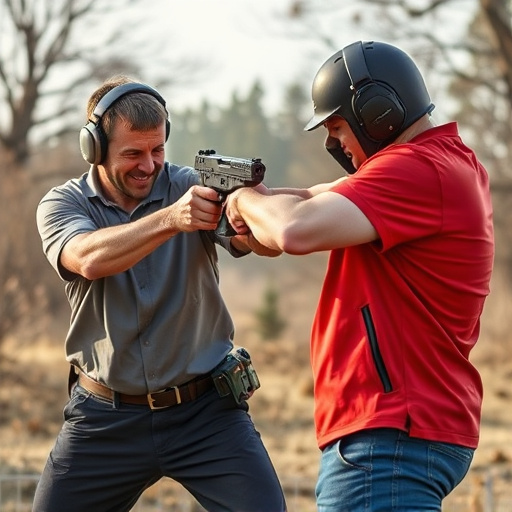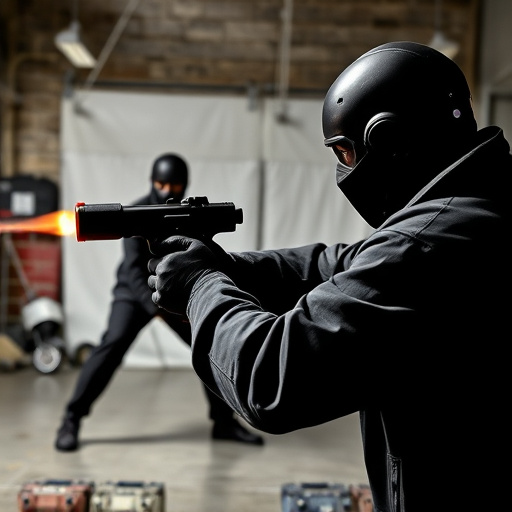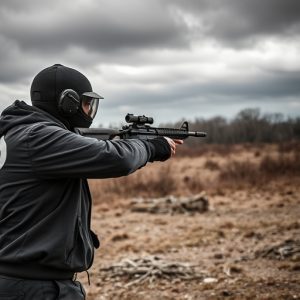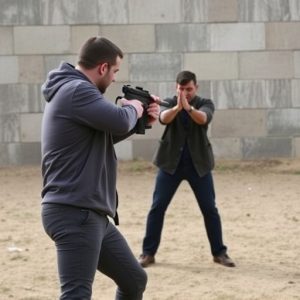Non-Lethal Weapon Training: Certifying Officers for Safe Disabilitation
Non-lethal weapon training equips law enforcement with skills to handle less-lethal force tools resp…….
Non-lethal weapon training equips law enforcement with skills to handle less-lethal force tools responsibly, focusing on understanding neuromuscular effects of stun devices and other technologies. This enables informed decision-making in de-escalating tense situations using Tasers, pepper spray, impact weapons, and tactical strategies for crowd control and crisis negotiation. Certification programs blend theoretical knowledge with hands-on training, emphasizing critical thinking, decision-making, and de-escalation techniques to ensure public safety while minimizing injuries. As technology advances, these programs evolve through detailed case studies, VR simulations, and a deeper understanding of neuromuscular effects, aiming to enhance proficiency and adhere to ethical standards.
In an era where public safety and law enforcement tactics continue to evolve, understanding non-lethal weapon training is more crucial than ever. This comprehensive guide delves into the intricacies of non-lethal force certification programs, focusing on stun devices and their neuromuscular effects. From the role of stun guns in modern security to real-world application scenarios, this article explores the benefits, challenges, and future trends shaping law enforcement’s non-lethal weapon training landscape.
- Understanding Non-Lethal Weapon Training: A Comprehensive Overview
- The Role of Stun Devices in Law Enforcement and Security
- Unveiling the Neuromuscular Effects: How Stun Guns Disabilitate
- Certification Process: Preparing Officers for Real-World Scenarios
- Benefits and Challenges of Non-Lethal Force Training
- Future Trends in Non-Lethal Weapon Certification Programs
Understanding Non-Lethal Weapon Training: A Comprehensive Overview

Non-lethal weapon training, also known as less-lethal weapon certification, equips individuals with specialized skills and knowledge to handle non-deadly force tools effectively and responsibly. This type of training is crucial for law enforcement agencies, security personnel, and others who may need to de-escalate tense situations without resorting to lethal force. The focus lies in understanding neuromuscular effects of stun devices and other non-lethal technologies, allowing trainees to make informed decisions based on real-time assessments of a subject’s behavior.
Comprehensive programs cover various aspects, including hands-on training with equipment like Tasers, pepper spray, and impact weapons, as well as tactical strategies for crowd control, arrest procedures, and crisis negotiation. Trainees learn how to recognize signs of distress or resistance in subjects, enabling them to apply the appropriate non-lethal techniques. By mastering these skills, professionals can better navigate challenging scenarios, ensuring public safety while minimizing the risk of injuries associated with lethal force.
The Role of Stun Devices in Law Enforcement and Security

Stun devices, also known as tactical electronic control weapons (ECWs), play a significant role in modern law enforcement and security strategies. These non-lethal weapons utilize the neuromuscular effects of high-voltage, low-current electrical impulses to temporarily disable or disrupt an individual’s physical capabilities. The primary goal is to incapacitate suspects without causing permanent harm, allowing officers to gain control and ensure public safety during various situations.
The neuromuscular impact of stun devices disrupts the neural signals responsible for muscle movement, leading to a loss of balance, strength, and coordination in the targeted individual. This rapid and temporary paralysis gives law enforcement personnel valuable time to restrain or subdue a resistant suspect, de-escalate potentially dangerous scenarios, and maintain order during high-stress incidents. With their non-lethal nature, stun devices offer a crucial alternative to traditional firearms, promoting a more controlled and strategic approach to law enforcement tactics.
Unveiling the Neuromuscular Effects: How Stun Guns Disabilitate

The neuromuscular effects of stun devices are a key aspect to understand in non-lethal weapon training. When a stun gun discharges, it delivers an electric current that overrides the body’s natural electrical signals. This disruption specifically targets the muscles, causing them to contract involuntarily and leading to temporary paralysis or “stunning.” The intensity of this effect varies with the device’s settings and contact points on the target’s body, but it consistently disables the individual without causing permanent harm.
These devices disrupt the neuromuscular system by interfering with nerve impulses. This interference results in a loss of motor control, allowing users to subdue an assailant temporarily. The impact can range from disorienting the attacker to immobilizing them, providing crucial time for backup or escape. Understanding these neuromuscular effects is essential in non-lethal weapon certification training, ensuring individuals grasp how stun guns effectively disable and de-escalate situations without causing fatal injuries.
Certification Process: Preparing Officers for Real-World Scenarios

The certification process for non-lethal weapon training, particularly focusing on stun devices, is meticulously designed to prepare law enforcement officers for real-world scenarios. It involves a comprehensive program that combines theoretical knowledge with practical application. Candidates learn about the neuromuscular effects of stun devices, understanding how these tools disrupt an individual’s motor functions without causing permanent harm. This knowledge equips officers to make informed decisions in high-pressure situations, ensuring safety for both the officer and the subject.
Practical training sessions simulate various scenarios, allowing officers to practice deploying stun devices effectively while minimizing injury risk. The certification process emphasizes critical thinking, decision-making skills, and de-escalation techniques, all of which are crucial when dealing with individuals in distress or under the influence. Through rigorous evaluation and ongoing refresher courses, law enforcement agencies ensure that their officers maintain proficiency, enabling them to respond effectively and responsibly to diverse public safety challenges.
Benefits and Challenges of Non-Lethal Force Training

Non-lethal force training offers a unique set of advantages in law enforcement and security operations, allowing professionals to de-escalate tensions and control situations without causing permanent harm. One of the key benefits is the focus on neuromuscular effects of stun devices, which temporarily incapacitate individuals through targeted electrical impulses. This approach ensures officers can subdue suspects effectively while minimizing collateral damage and reducing the risk of fatal injuries.
However, challenges exist in implementing such training programs. These include ensuring that trainees understand the nuanced application of non-lethal force to avoid excessive use of force and respecting individual rights. Additionally, keeping up with technological advancements in stun devices and their effectiveness requires continuous education and practical exercises to maintain proficiency and stay ahead in a rapidly evolving field.
Future Trends in Non-Lethal Weapon Certification Programs

As technology advances, non-lethal weapon certification programs are also evolving to keep pace with the changing landscape of law enforcement and security. One emerging trend is a greater focus on understanding the neuromuscular effects of stun devices. By delving deeper into how these tools interact with the body’s nervous system, training can become more precise and effective. This involves studying the specific physiological responses triggered by stun guns and other non-lethal weapons, allowing certification programs to update their curricula to include detailed case studies and practical exercises that mimic real-world scenarios.
Additionally, virtual reality (VR) simulations are increasingly being integrated into non-lethal weapon training. VR technology offers a safe and controlled environment for trainees to practice their skills without endangering others. This innovative approach enables officers to experience a wide range of situations, from crowd control to self-defense, enhancing their decision-making abilities and overall proficiency with non-lethal tools. As these trends continue to develop, the future of non-lethal weapon certification promises to be more comprehensive, evidence-based, and ultimately, more effective in ensuring public safety while adhering to ethical standards.
The evolution of non-lethal weapon training certification programs, focusing on understanding the neuromuscular effects of stun devices, plays a pivotal role in enhancing law enforcement and security strategies. By equipping officers with comprehensive skills and knowledge through rigorous training, these programs ensure a balanced approach to public safety. As technology advances, future trends in non-lethal weapon certification promise to further refine officer capabilities, promoting safer and more effective interactions while mitigating risks associated with traditional force methods.


